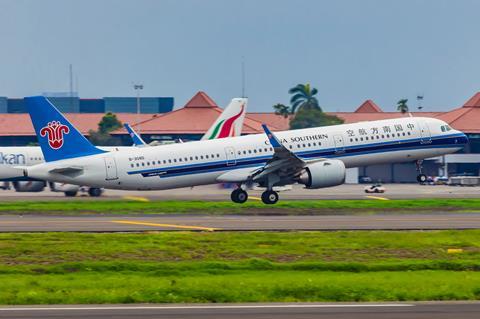China Southern Airlines became the first of the country’s three largest carriers to eke out a small operating profit following the coronavirus pandemic, as its compatriots narrow their losses on the back of travel demand recovery.
In their respective half-year financial results, the ‘Big Three’ – comprising Air China, China Eastern Airlines and China Southern – reported significant jumps in passenger travel revenue, following the easing of Covid-19 travel restrictions earlier this year.

Beijing abruptly scrapped most of its ‘zero-Covid’ curbs in January, allowing domestic travel without restrictions, and reopening international borders that were tightly shut for nearly three years.
For the six months to 30 June, China Southern swung to an operating profit of CNY1.4 billion ($192 million), reversing the CNY10.6 billion loss in the year-ago period.
The Guangzhou-based carrier reported a 76% jump in revenues to CNY71.8 billion, with passenger revenue more than doubling year on year.
China Southern carried close to 65 million passengers systemwide, more than double year on year. Traffic also saw a two-fold increase, with capacity increasing 92% against the year-ago period.
Costs rose 35% to CNY72.2 billion, with flight operations costs leading the increase as the airline mounted more flights following the easing of restrictions.
The airline reported a net loss during the half-year of around CNY2.9 billion, narrowing from the CNY11.5 billion loss last year.
Compatriot China Eastern, meanwhile, was CNY2.6 billion in the red at the operating level for the half-year. This compares to the record CNY15.7 billion loss chalked up in the year-ago period.
This was despite revenue more than doubling to CNY52 billion, of which passenger revenue tripled year on year. The airline carried 51.9 million passengers during the period, more than double compared to 2022’s first-half.
Half-year costs saw a 48% jump to CNY54.6 billion, with the sharpest increases seen in fuel and flight operation costs.
The SkyTeam carrier posted a net loss of CNY6.2 billion, an improvement from the CNY18.7 billion net loss last year.
Meanwhile, Air China disclosed an operating loss of CNY898 million in the half-year, significantly narrowing from the CNY17 billion loss in the year-ago period.
Like its compatriots, the Beijing-based operator saw revenues more than double to CNY63.7 billion. Passenger traffic in the six-month period tripled year on year, while capacity grew more than two-fold.
Operating expenses saw a 52% increase year on year to CNY64.6 billion, as the airline ramped up its operations.
Air China reported a net loss of CNY3.4 billion, compared to the CNY19.4 billion loss in the year-ago period.
AIRLINES FLAG ‘IMBALANCED’ DEMAND, COMPETITION
In their outlook for the second half of 2023, the ‘Big Three’ note that the recovery is expected to continue with the summer peak travel period, as well as China’s National Day holidays in early October.
However, some have warned of “intensified” competition – both domestic and international – as the Chinese air travel sector recovers.
Says China Southern: “[If] the company fails to effectively enhance its ability to predict and adopt flexible sales strategies and pricing mechanisms, it may have an impact on the company’s goal of achieving expected returns.”

The airline, along with China Eastern, also spoke of “imbalanced” demand between international and domestic operations.
China Eastern notes that international travel demand has been slower to recover than expected.
“China’s civil aviation industry is expected to recover and grow rapidly, but at the same time, it is under the pressure of imbalanced domestic supply and demand and the lagging recovery of international routes,” the carrier states.
China Southern adds: “In terms of exploring the international market, if the company fails to further improve the operational quality of international routes, it may affect the company’s operating income and profit levels.”


























